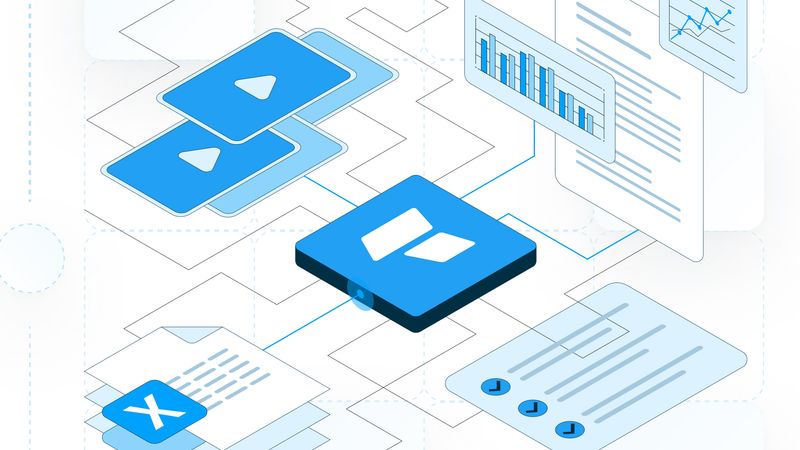In a recent webinar, "From Insight to Action: How AI Empowers EHS & Operations Leaders to Drive Impact" , we brought together two industry leaders to tackle a critical issue in safety and operations: the growing gap between the amount of data being collected and the ability to use that data to take meaningful action.
Our host, Dan Hobbs, CEO of Protex AI, was joined by panelist Lucas Dominguez, Founder & CEO of Shield 360, for a dynamic conversation. They explored the hidden barriers holding safety teams back, the limitations of current technology, and how AI is paving the way for a proactive, predictive future.
Here are the key takeaways from their discussion.
The "Reactive Safety Trap": Why We're Stuck Looking Backwards
Lucas kicked off the discussion by identifying a common struggle he calls the "reactive safety trap", a series of issues that keep safety professionals focused on past events rather than future risks.
- Disconnected Data: Lucas pointed out that while data is everywhere, it's often fragmented and stored in silos. Whether in EHS software, Excel spreadsheets, or other improvised systems, consolidating this data is a major challenge.
- Limited Resources: As Lucas noted, safety functions are often small teams with limited resources. Very few organizations have the luxury of a dedicated health and safety data analyst, leaving the time-consuming task of manual analysis to the safety professionals themselves.
- A Foundation of Lagging Indicators: This combination of disconnected data and manual analysis means teams are still planning based on lagging indicators. As Dan highlighted, "the data we might see now is already lagging to lead to better decisions". Even with the best tools, we're often waiting for something to go wrong before we can act.
From Static to Dynamic: The Next Evolution of Safety Tech
Both speakers agreed that while technology has helped, it has its limits. Lucas explained that most EHS software platforms are great for structure and audits, but they are "fundamentally reactive tools" that provide "static data" about something that has already happened.
Dan shared the powerful origin story of Protex AI to illustrate this point. After a serious forklift incident, a review of CCTV footage showed that the risky behaviors leading to it "were happening all the time". The warnings were there, but the data wasn't being analyzed proactively.
To break this cycle, Lucas introduced the concept of "Safety 4.0". He argued that as the industry embraces Industry 4.0, with its sensors, cloud computing, and real-time data, safety "cannot afford to stay behind". The future lies in leveraging dynamic, real-time data to move from a reactive to a proactive stance.
The Proactive Revolution: Using AI as a Crystal Ball
So, how do leaders make that leap to proactive decision-making? The answer lies in AI-powered predictive analytics.
Dan explained how new AI tools can act as a "crystal ball for safety professionals". These systems can connect to all the disconnected data pools a company has, from messy Excel exports to text-heavy incident reports and even live video feeds, to find hidden patterns.
- Predicting the "Where and When": Lucas emphasized that the goal is no longer just to tell a story about the past, but "to predict... when and where the next instance will happen". Dan added that AI can flag exactly where to direct attention before an incident occurs.
- Handling Messy Data: An audience member asked if data needs to be perfectly clean for these tools to work. Lucas clarified that the "beauty of AI" is its ability to analyze both structured (quantitative) and unstructured (qualitative text) data, finding insights that would take a human analyst weeks or months to uncover.
The Evolving EHS Leader: Your Role in the Age of AI
A major theme of the conversation was how AI will enhance, not replace, the role of the safety leader. Lucas shared a powerful insight he tells his peers: "You're not going to get replaced by AI. But we could get replaced by the person who knows about it more than you".
Lucas urged leaders to see technology as a way to automate the data-gathering and analysis that keeps them behind a desk. By letting AI handle the data, leaders can "spend this time on the shop floor talking with the team, guiding them, doing risk assessments". Dan concluded that to be a fantastic leader today, "you need to get technology in your hands".
Your Journey From Insight to Action Starts Now
The overarching message from the webinar was clear: the tools and data to build a truly proactive safety culture are more accessible than ever. Getting started doesn't require a background in coding or a massive budget.
Lucas advised leaders to not be afraid and to be open to using AI. As Dan noted, "it's not this huge moonshot you got to prepare a rocket for. You can really just experiment with it". While it's important to be aware of risks like data privacy and model accuracy, the biggest risk is standing still.
Ultimately, the conversation was a call to action for every EHS and Operations leader. As Lucas stated, "if you're not yet embracing technology, you are not going to lead, in the digital age". The journey from insight to action begins with curiosity and the courage to take the first step. By embracing these new technologies, you can shift your focus from reacting to the past to proactively shaping a safer, more efficient future.
See the Theory in Practice
Throughout the webinar, the speakers discussed how AI can transform complex, disconnected data into clear, predictive insights. Dan referred to this as a "crystal ball for safety professionals," capable of forecasting where the next incident might occur.
If you're curious to see a practical application of these concepts, you can learn more about the technology that makes it possible at the link below.
Check Out Our Industry
Leading Blog Content
EHSQ industry insights, 3rd Gen EHSQ AI-powered technology opinions & company updates.




.jpg)
